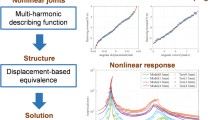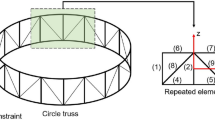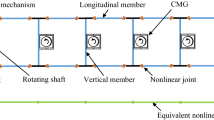Abstract
This paper presents a nonlinear response of a planar repetitive space truss with polynomial-nonlinear joints based on a multi-harmonic equivalent continuum beam model. The nonlinear joints are modeled as the multi-harmonic dynamic stiffness matrix with eccentricity. To overcome the limitation of classical equivalent method based on energy, a high-order displacement equivalent modeling method is proposed, where the micro-rotation is included to improve the accuracy and avoid the pseudo inverse of matrix. Furthermore, in the experiment, a novel suspension device used to support the space truss structure is designed, which not only offsets the gravity but allows the truss to bend and twist freely on the granite table. A bending sweeping test was conducted to obtain the nonlinear frequency response of bending and bending-torsion coupling of the space truss. The results show the similar nonlinear characteristic between the nonlinearity of joints and the repetitive truss. During the vibration test, the coupled torsional vibration of planar repetitive truss has a larger amplitude at the bending resonance frequencies, rather than at the torsion resonance frequencies, indicating a nonlinear bending-torsion coupling feature.








Similar content being viewed by others
References
Gao X, Jin D, Hu H (2017) Internal resonances and their bifurcations of a rigid-flexible space antenna. Int J Non-Linear Mech 94:160–173. https://doi.org/10.1016/j.ijnonlinmec.2017.03.020
Liu F, Wang L, Jin D, Liu X, Lu P (2020) Equivalent micropolar beam model for spatial vibration analysis of planar repetitive truss structure with flexible joints. Int J Mech Sci 165:105202. https://doi.org/10.1016/j.ijmecsci.2019.105202
Dai L, Guan F, Guest JK (2014) Structural optimization and model fabrication of a double-ring deployable antenna truss. Acta Astronaut 94:843–851. https://doi.org/10.1016/j.actaastro.2013.10.002
Bauchau OA, Rodriguez J (2002) Modeling of joints with clearance in flexible multibody systems. Int J Solids Struct 39:41–63. https://doi.org/10.1016/S0020-7683(01)00186-X
P Flores, R Leine, C Glocker (2011) Modeling and analysis of rigid multibody systems with translational clearance joints based on the nonsmooth dynamics approach, In Editor K. Arczewski, W. Blajer, J. Fraczek, M. Wojtyra (Eds.), Multibody Dyn., Springer Netherlands, Dordrecht, 107–130, doi: https://doi.org/10.1007/978-90-481-9971-6_6.
Berger E (2002) Friction modeling for dynamic system simulation. Appl Mech Rev 55:535–577. https://doi.org/10.1115/1.1501080
Albender F, Symens W, Swevers J, Van Brussel H (2004) Theoretical analysis of the dynamic behavior of hysteresis elements in mechanical systems. Int J Non-Linear Mech 39:1721–1735. https://doi.org/10.1016/j.ijnonlinmec.2004.04.005
Hassani V, Tjahjowidodo T, Do TN (2014) A survey on hysteresis modeling, identification and control. Mech Syst Signal Process 49:209–233. https://doi.org/10.1016/j.ymssp.2014.04.012
Chen X, Jiang S (2022) Nonlinear dynamic behavior analysis of multi-linkage mechanism with multiple lubrication clearances. Eur J Mech - BFluids 91:177–193. https://doi.org/10.1016/j.euromechflu.2021.10.006
Flores P, Ambrósio J (2004) Revolute joints with clearance in multibody systems. Comput Struct 82:1359–1369. https://doi.org/10.1016/j.compstruc.2004.03.031
Fonseca IM, Bainum PM, Lourenção PTM (2002) Structural and control optimization of a space structure subjected to the gravity-gradient torque. Acta Astronaut 51:673–681. https://doi.org/10.1016/S0094-5765(02)00024-3
Allen M, Bernelli-Zazzera F, Scattolini R (2000) Sliding mode control of a large flexible space structure. Control Eng Pract 8:861–871. https://doi.org/10.1016/S0967-0661(00)00004-6
Noor AK, Nemeth MP (1980) Micropolar beam models for lattice grids with rigid joints. Comput Methods Appl Mech Eng 21:249–263. https://doi.org/10.1016/0045-7825(80)90034-1
Noor AK, Russell WC (1986) Anisotropic continuum models for beamlike lattice trusses. Comput Methods Appl Mech Eng 57:257–277. https://doi.org/10.1016/0045-7825(86)90141-6
Dow JO, Su ZW, Feng CC, Bodley C (1985) Equivalent continuum representation of structures composed of repeated elements. AIAA J 23:1564–1569. https://doi.org/10.2514/3.9124
Berry DT, Yang TY, Skelton RE (1985) Dynamics and control of lattice beams using simplified finite element models. J Guid Control Dyn 8:612–619. https://doi.org/10.2514/3.20030
C Sun, S Liebbe (1986) A global-local approach to solving vibration of large truss structures, in: 27th Struct. Struct. Dyn. Mater. Conf., American Institute of Aeronautics and Astronautics, San Antonio, TX, USA, doi: https://doi.org/10.2514/6.1986-872.
Wu JS (1994) Dynamic Analysis of Spatial Beam-like Lattice Girders. Comput Struct 53:961–981. https://doi.org/10.1016/0045-7949(94)90383-2
Ziegler E, Accorsi M, Bennett M (2004) Continuum plate model for lattice block material. Mech Mater 36:753–766. https://doi.org/10.1016/j.mechmat.2003.06.002
Fan H, Yang W (2006) An equivalent continuum method of lattice structures. Acta Mech Solida Sin 19:103–113. https://doi.org/10.1007/s10338-006-0612-x
Tollenaere H, Caillerie D (1998) Continuous modeling of lattice structures by homogenization. Adv Eng Softw 29:699–705. https://doi.org/10.1016/S0965-9978(98)00034-9
Penta F, Monaco M, Pucillo GP, Gesualdo A (2017) Periodic beam-like structures homogenization by transfer matrix eigen-analysis: A direct approach. Mech Res Commun 85:81–88. https://doi.org/10.1016/j.mechrescom.2017.08.007
Dos Reis F, Ganghoffer JF (2012) Construction of micropolar continua from the asymptotic homogenization of beam lattices. Comput Struct 112–113:354–363. https://doi.org/10.1016/j.compstruc.2012.08.006
Nagem RJ, Williams JH (1989) Dynamic analysis of large space structures using transfer matrices and joint coupling matrices. Mech Struct Mach 17:349–371. https://doi.org/10.1080/089054508915646
Stephen NG (2006) Transfer matrix analysis of the elastostatics of one-dimensional repetitive structures. Proc R Soc Math Phys Eng Sci 462:2245–2270. https://doi.org/10.1098/rspa.2006.1669
Liu F, Jin D, Wen H (2017) Equivalent dynamic model for hoop truss structure composed of planar repeating elements. AIAA J 55:1058–1063. https://doi.org/10.2514/1.J055162
Fan HL, Jin FN, Fang DN (2009) Nonlinear mechanical properties of lattice truss materials. Mater Des 30:511–517. https://doi.org/10.1016/j.matdes.2008.05.061
Zhang W, Chen J, Sun Y (2016) Nonlinear breathing vibrations and chaos of a circular truss antenna with 1:2 internal resonance. Int J Bifurc Chaos 26:1650077. https://doi.org/10.1142/S0218127416500772
Friswell MI, Penny JET, Garvey SD (1995) Using linear model reduction to investigate the dynamics of structures with local non-linearities. Mech Syst Signal Process 9:317–328. https://doi.org/10.1006/mssp.1995.0026
Peng L, Mohseni K (2016) Nonlinear model reduction via a locally weighted POD method. Int J Numer Methods Eng 106:372–396. https://doi.org/10.1002/nme.5124
Bai Z (2002) Krylov subspace techniques for reduced-order modeling of large-scale dynamical systems. Appl Numer Math 43:9–44. https://doi.org/10.1016/S0168-9274(02)00116-2
M Webster, W Vande (1991) Modelling beam-like space trusses with nonlinear joints, in: 32nd Struct. Struct. Dyn. Mater. Conf., American Institute of Aeronautics and Astronautics, Baltimore, MD, USA, https://doi.org/10.2514/6.1991-1225.
Salehian A, Inman DJ (2008) Dynamic analysis of a lattice structure by homogenization: Experimental validation. J Sound Vib 316:180–197. https://doi.org/10.1016/j.jsv.2008.02.031
Liu F, Wang L, Jin D, Wen H (2019) Equivalent continuum modeling of beam-like truss structures with flexible joints. Acta Mech Sin 35:1067–1078. https://doi.org/10.1007/s10409-019-00872-z
Liu F, Wang L, Jin D, Liu X, Lu P (2021) Equivalent beam model for spatial repetitive lattice structures with hysteretic nonlinear joints, Int J Mech Sci 200:106449. https://doi.org/10.1016/j.ijmecsci.2021.106449.
Ferreira JV, Ewins DJ (1997) Algebraic nonlinear impedance equation using multi-harmonic describing function. Society for Experimental Mechanics, Bethel, CT, pp 1595–1601
Lee U (2000) Vibration analysis of one-dimensional structures using the spectral transfer matrix method. Eng Struct 22:681–690. https://doi.org/10.1016/S0141-0296(99)00002-4
Noor K, Nemeth P (1980) Analysis of spatial beamlike lattices with rigid joints. Comput Methods Appl Mech Engrg 24:35–59. https://doi.org/10.1016/0045-7825(80)90039-0
Acknowledgements
This work was funded by the National Natural Science Foundation of China under Grant No. 11827801, 12172181 and 11732006.
Author information
Authors and Affiliations
Corresponding author
Ethics declarations
Conflict of interest
The authors declare that they have no conflict of interest.
Additional information
Publisher's Note
Springer Nature remains neutral with regard to jurisdictional claims in published maps and institutional affiliations.
Appendices
Appendix A
1.1 Multi-harmonic describing function method
Let \(y(t)\) and \(\dot{y}(t)\) be the relative joint deformation and its derivative with respect to time \(t\), \(f_s (t)\) and \(f_d (t)\) the stiffness and damping force of nonlinear joint in the time domain. Assuming that \(f_s (t)\) and \(f_d (t)\) are the polynomial function of \(y(t)\) and \(\dot{y}(t)\), respectively. For convenience of expression, the time t will be omitted in what follows. To deal with nonlinearity, the multi-harmonic describing function method (MHDFM) proposed by Ferreira and Ewins [36] will be introduced and extended to obtain a new hybrid element.
If the motion of system is periodic, the nonlinear force and displacement of joint, in truncated Fourier coefficients up to \(N_H\) harmonics, can be written
where \(F_k^s\), \(F_k^d\) and \(Y_k\) are the \(k\)-th Fourier coefficient of \(f_s\), \(f_d\) and \(y\). Since no additional information is contained in the conjugated complex parts, equation (A.1) can be simplified as
Note that \(F_k^s\) and \(F_k^d\) can be expressed in the analytical form.
where \(G_{ki}\) and \(D_{ki}\), the element of matrix \({\bf{G}}\) and \({\bf{D}}\), are given by
and \(y^{[i]}\) denotes the periodic signal of the joint deformation including k harmonics.
According to Eq. (A.4), the multi-harmonic dynamic stiffness matrix Δ of the nonlinear joint can be obtained as
and the constitutive equation of the three-dimension nonlinear joint in the frequency domain reads
where \({\bf{F}}_c\) is the multi-harmonic vector consisting of the internal forces and moments of the joint along three directions of the local coordinate system, \({\bf{Y}}_c\) is the multi-harmonic vector made up of the corresponding deformation of the joint, and \({\bf{S}}_c\) is assembled by the matrix Δ.
Appendix B
2.1 Constitutive equation of hybrid beam element
The Euler beam equation with the material damping ratio \(\eta\) and the linear viscous damping \(c_v\) can be written as
where \(E\),\(I\),\(\rho\),\(A\) and \(L\) are Young’s modulus, the second-moment inertia of cross section, mass density, the area of the cross-section, and length of beam, respectively. The wavenumbers for pure bending \(k_F\) and torsion \(k_T\) arrive at
Then the spectral element matrix of Euler beam [37] is obtained
where \({\bf{F}}_B\) and \({\bf{U}}_B\) are the nodal force and displacement of two beam nodes in Fourier coefficients.
Consider the two nonlinear joints at the both ends of the Euler beam, Eq. (A.7) becomes
where \({\bf{F}}_C\) and \({\bf{Y}}\) are the multi-harmonic vectors of internal force and relative displacement of two joints, respectively. \({\bf{S}}_{Ac}\) and \({\bf{S}}_{Bc}\) denote the \({\bf{S}}_c\) of two joints A and B.
Let \({\bf{U}}_{nd}\)(\(nd \in\){\(Ae\),\(Ac\),\(Ab\),\(Bb\),\(Bc\),\(Be\)}) represent the multi-harmonic displacement vector of node \(nd\). If the connection blocks are assumed to be rigid, the joint displacement \({\bf{Y}} = [{\bf{U}}_{Ac}^{\text{T}} - {\bf{U}}_{Ab}^{\text{T}} ,{\bf{U}}_{Bc}^{\text{T}} - {\bf{U}}_{Bb}^{\text{T}} ]^{\text{T}}\) can be written as
where \({\bf{U}}_B = [{\bf{U}}_{Ab}^{\text{T}} ,{\bf{U}}_{Bb}^{\text{T}} ]^{\text{T}}\), \({\bf{U}}_E = [{\bf{U}}_{Ae}^{\text{T}} ,{\bf{U}}_{Be}^{\text{T}} ]^{\text{T}}\) and \({\bf{E}}\) denotes the transformation matrix from \({\bf{U}}_C = [{\bf{U}}_{Ac}^{\text{T}} ,{\bf{U}}_{Bc}^{\text{T}} ]^{\text{T}}\) to \({\bf{U}}_E\) considering the length of connection blocks
The deformation compatibility equation can be found by considering the condition of displacement equivalence, namely
where
with \({\bf{0}}\) being the zero matrix and \({\bf{e}}\) the diagonal matrix with the element e denoting the length (or eccentricity) of connection blocks. The relation between the relative displacement of joints and the node displacement of the hybrid beam element are described as follows
Consequently, the constitutive equation of joint-beam-joint shown in Fig. 1b can be assembled by Eqs. (B.3) and (B.4) to the following form
The condensed constitutive equation can be expressed by the dynamic condensation
Taking the mass and length of the connection blocks into account, one can derive the force-balance equation considering the beam-joint element with two rigid connection blocks, i.e.,
where \({\bf{M}}_E\) stands for the mass and moment of inertia of the connection blocks.
Combining the Eqs. (B.9), (B.11) and (B.12) yields the following constitutive matrix of hybrid beam element
Rights and permissions
Springer Nature or its licensor (e.g. a society or other partner) holds exclusive rights to this article under a publishing agreement with the author(s) or other rightsholder(s); author self-archiving of the accepted manuscript version of this article is solely governed by the terms of such publishing agreement and applicable law.
About this article
Cite this article
Li, X., Wei, G., Guo, J. et al. Nonlinear response of a planar repetitive space truss with joints based on multi-harmonic equivalent model. Meccanica 58, 1495–1510 (2023). https://doi.org/10.1007/s11012-023-01660-7
Received:
Accepted:
Published:
Issue Date:
DOI: https://doi.org/10.1007/s11012-023-01660-7




